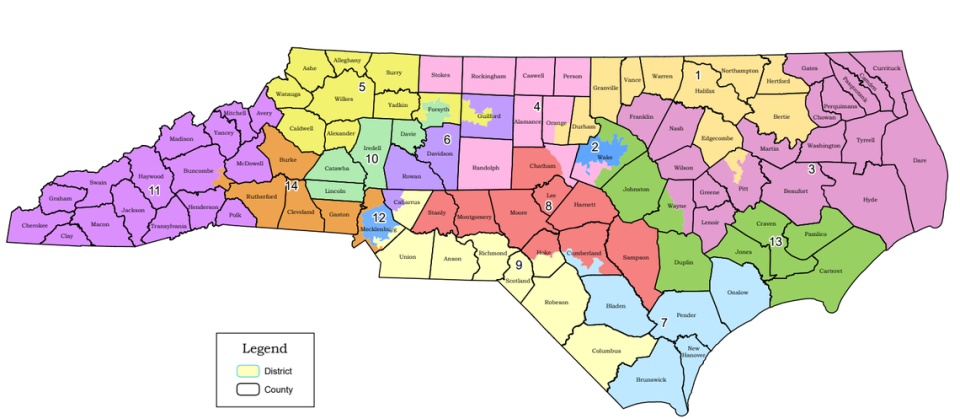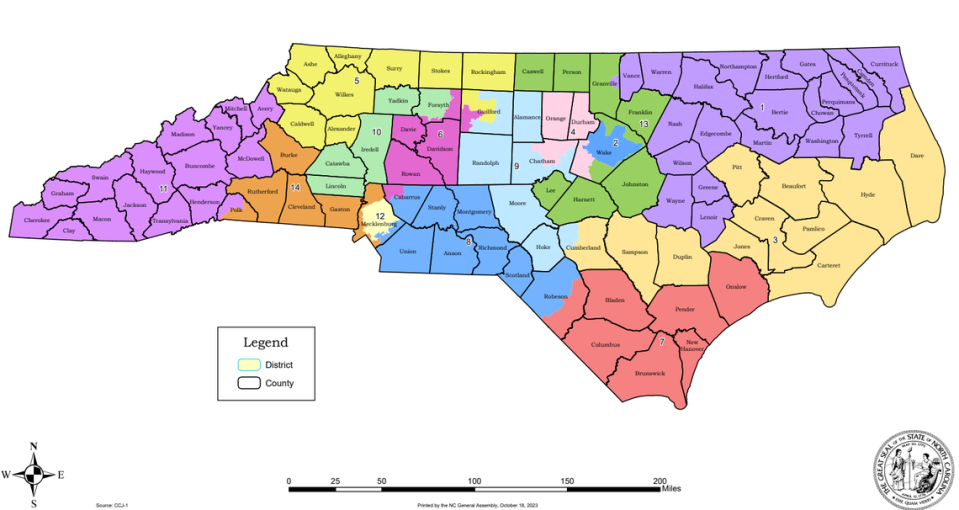The Triangle’s swing district would be eliminated in GOP congressional maps
A highly competitive congressional district that includes southern Wake County, which elected Democratic U.S. Rep. Wiley Nickel in 2022, would become a likely Republican pickup under new electoral maps GOP lawmakers released Wednesday.
North Carolina’s 13th Congressional District emerged from a lengthy court battle over claims of partisan gerrymandering as the only tossup in the map drawn by court-appointed experts that was ultimately used in last year’s election.
Nickel, a former state lawmaker from Cary who served two terms in the state Senate, won that election by defeating Republican Bo Hines by just over 3 percentage points. He began his first term representing the district in January.
Under two proposed congressional maps N.C. Senate Republicans released on Wednesday, however, the 13th district Nickel currently represents would no longer be a swing district. Instead, it’s one of at least three districts with Democratic incumbents that would favor the GOP by a considerable margin, giving U.S. House Republicans the prospect of picking up three, if not four, additional seats from North Carolina alone.
The 13th district, under the court-drawn map that was only allowed to be in place for the 2022 cycle, covers southern Wake County, including a portion of downtown and Southeast Raleigh, as well as all of Johnston County and parts of Wayne and Harnett counties.
The new proposals would significantly change the district’s boundaries. One of the proposed maps, filed as Senate Bill 756, would extend the district from the northern and eastern edges of Wake County all the way to coastal Carteret County. In between those two ends, it would cover all of Johnston County, a portion of Wayne County and all of Duplin, Jones, Craven and Pamlico counties.

This version of the 13th district would lean Republican by a margin of 56.83% to 40.94% for Democrats, according to the website Dave’s Redistricting, which analyzes data from previous elections.
Another version of the 13th district, proposed in Senate Bill 757, would instead wrap around Wake County, covering all of Lee, Harnett, and Johnston counties, parts of southern, eastern and northern Wake, and all of Franklin, most of Granville, and all of Person and Caswell counties to the north.

Under these boundaries, the district would lean Republican by a margin of 56.9% to 40.79% for Democrats, according to Dave’s Redistricting.
While it’s not yet clear why Senate Republicans filed two proposals for the congressional map, or which map lawmakers will vote on next week and put in place for next year’s election, it’s clear that Nickel or other Democrats would face an uphill battle running from either of the new versions of the district.
Nickel hasn’t yet addressed his reelection plans. On Wednesday evening, he said the GOP maps were “self-serving, partisan maps,” writing on social media: “I’ll always fight for fair maps, to end partisan gerrymandering, and to protect the right to vote for every North Carolinian.”
Kevin Porter, a spokesperson for Nickel, said on Wednesday that Nickel’s office was still reviewing the maps.
On the Republican side, GOP state Rep. Erin Paré, who announced she was running for Congress from the 13th district back in August, told The News & Observer on Wednesday that she will still file to run from the 13th district if the map outlined in SB 757 is enacted.
If the map in SB 756 is enacted, Paré said, she plans to run in either the 13th district or the 4th district, which includes her home in Holly Springs and extends to Rockingham and Stokes counties, northwest of Wake. Both districts include a portion of her current state House district.


